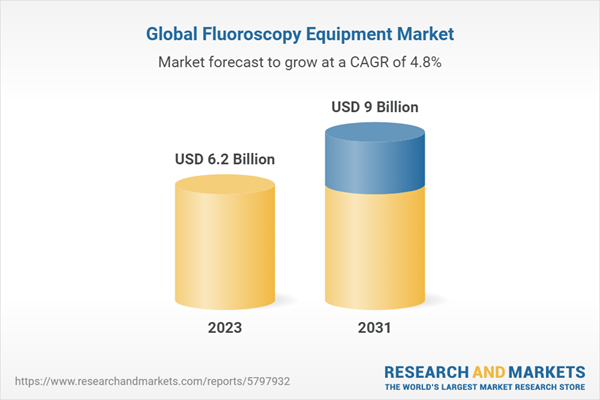Fluoroscopy Equipment Introduction
Fluoroscopy equipment refers to medical imaging devices that use X-rays to produce real-time moving images of the internal structures of the body. These devices are used in a variety of medical procedures, including diagnosing and treating injuries, illnesses, and diseases. Fluoroscopy equipment has several applications in medical specialties such as cardiology, orthopaedics, gastroenterology, and urology.The market for fluoroscopy equipment is driven by the increasing prevalence of chronic diseases such as cardiovascular diseases, cancer, and gastrointestinal disorders. The rising geriatric population and growing demand for minimally invasive surgeries are also driving the market growth. Moreover, the increasing preference for digital fluoroscopy systems over conventional systems and technological advancements such as the development of flat-panel detectors are expected to drive the growth of the fluoroscopy equipment market.
However, the high cost of fluoroscopy equipment and the potential health risks associated with radiation exposure during fluoroscopy procedures are likely to hinder market growth. The lack of trained professionals to operate and interpret the results of fluoroscopy procedures is also a significant challenge for the market. Nonetheless, increasing investment in research and development and strategic collaborations among key players are expected to create growth opportunities for the market.
Fluoroscopy Equipment Market Scenario
Fluoroscopy is a medical imaging technique that uses X-rays to obtain real-time images of the body's internal structures. Fluoroscopy equipment is used in various medical procedures, including interventional radiology, orthopaedic surgeries, and gastrointestinal procedures, to guide the physician during the procedure.The fluoroscopy equipment market is primarily driven by the increasing demand for minimally invasive surgeries, advancements in imaging technology, and rising prevalence of chronic diseases. The market is also fueled by the growing geriatric population, as they are more susceptible to chronic diseases and require frequent medical interventions.
Moreover, the increasing demand for mobile C-arms, which are portable and versatile imaging systems used in various surgical procedures, is also driving the market growth. The market is expected to witness further growth in the coming years due to the increasing adoption of digital fluoroscopy systems, which offer several benefits over traditional analog systems, including higher image quality and lower radiation exposure.
However, the high cost of fluoroscopy equipment and the lack of skilled healthcare professionals to operate these devices may hinder the market growth to some extent.
Fluoroscopy Equipment Market Segmentations
Market Breakup by Product Type
- Fixed Fluoroscopy Equipment
- C- Arms
2. Full Size C-Arms
Market Breakup by Applications
- Diagnostic Lunch
- Surgical
- Others
Market Breakup by Classifications
- Marine Fluoroscopy Equipment Market
- Freshwater Fluoroscopy Equipment Market
Market Breakup by Region
North America
- United States of America
- Canada
Europe
- United Kingdom
- Germany
- France
- Italy
- Others
Asia Pacific
- China
- Japan
- India
- ASEAN
- Australia
- Others
Latin America
- Brazil
- Argentina
- Mexico
- Others
Middle East and Africa
- Saudi Arabia
- United Arab Emirates
- Nigeria
- South Africa
- Others
Key Trends in the Fluoroscopy Equipment Market
Key Trends in the Fluoroscopy Equipment Market:
- Increasing demand for minimally invasive procedures and surgeries is driving the market growth of fluoroscopy equipment
- Technological advancements such as the integration of artificial intelligence (AI) and 3D imaging are enhancing the capabilities of fluoroscopy equipment, leading to improved patient outcomes and higher accuracy
- Growing prevalence of chronic diseases such as cardiovascular and orthopaedic diseases is also driving the demand for fluoroscopy equipment
- Rising geriatric population and increasing healthcare expenditure in developing countries are expected to boost the market growth of fluoroscopy equipment
- The COVID-19 pandemic has further accelerated the adoption of fluoroscopy equipment, especially in the diagnosis and treatment of respiratory complications
- However, the high cost of fluoroscopy equipment and concerns related to radiation exposure to patients and healthcare professionals may hinder the market growth to some extent
- The trend of outpatient clinics and ambulatory surgical centres is increasing the demand for mobile and portable fluoroscopy equipment
Fluoroscopy Equipment Market: Competitor Landscape
The key features of the market report include patent analysis, grants analysis, clinical trials analysis, funding and investment analysis, partnerships, and collaborations analysis by the leading key players. The major companies in the market are as follows:- Siemens
- Trisonics
- Koninklijke Philips N.V
- Shimadzu Corporation
- Ziehm Imaging GmbH
- Toshiba Medical Systems Corporation
- Hitachi, Ltd, Carestream Health
- US Inc
- Hologic Inc
- lepumedical.com
- Agfa-Gevaert Group
- Adani Group
Table of Contents
Companies Mentioned
- Siemens
- Trisonics
- Koninklijke Philips N.V.
- Shimadzu Corporation
- Ziehm Imaging GmbH
- Toshiba Medical Systems Corporation
- Hitachi, Ltd, Carestream Health
- Us Inc.
- Hologic Inc.
- Lepumedical.Com
- Agfa-Gevaert Group
- Adani Group
Table Information
| Report Attribute | Details |
|---|---|
| No. of Pages | 140 |
| Published | May 2023 |
| Forecast Period | 2023 - 2031 |
| Estimated Market Value ( USD | $ 6.2 Billion |
| Forecasted Market Value ( USD | $ 9 Billion |
| Compound Annual Growth Rate | 4.8% |
| Regions Covered | Global |
| No. of Companies Mentioned | 12 |









